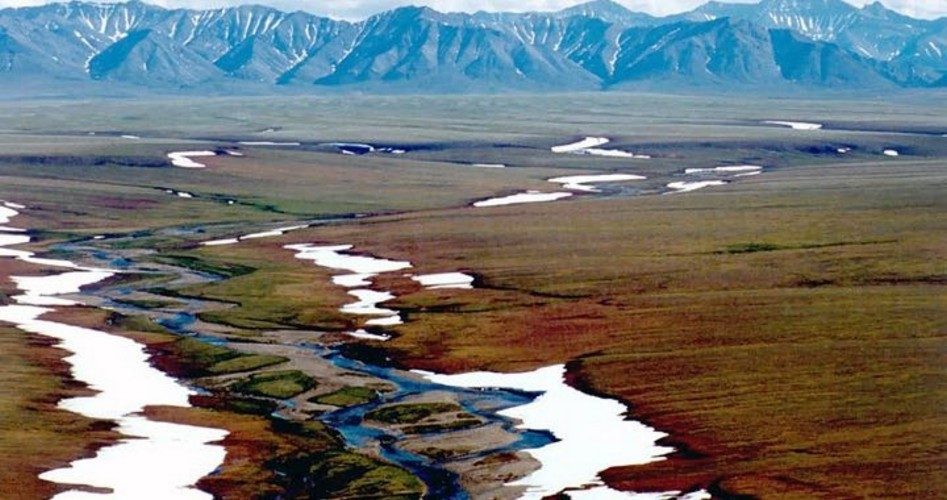
Part of the motivation by Republicans to open the Arctic National Wildlife Refuge (ANWR) to energy development — off limits for nearly 40 years thanks to environmental extremists and the Obama administration — is to use lease fees to offset the deficits in the tax reform bill.
The numbers coming from the Congressional Budget Office (CBO) are impressive. Leasing even a tiny part of the tiny part that “Section 1002” represents of the total ANWR acreage would produce $2.2 billion in revenues over the next 10 years, to be split evenly between Alaska and the federal government.
Alaska’s Republican Senator Lisa Murkowski said in a speech on the floor of the Senate late Tuesday night that Section 1002 is estimated to contain more than 10 billion barrels of recoverable oil which, if developed, would help supply some of America’s growing energy needs and create thousands of high-paying jobs for Alaskans. To put this into perspective, the Prudhoe Bay oil pool originally contained 25 billion barrels, while the National Petroleum Reserve — Alaska (NPR-A) — just west of the ANWR, contains less than a billion barrels.
Alaska could certainly use those jobs. The Alaska Pipeline’s production from the Prudhoe Bay peaked at two million barrels per day (bpd) in 1988, but as the field became depleted so did that flow. Today it’s less than 300,000 bpd with the field containing less than two billion barrels.
And Republicans could certainly use the revenues from leasing out parts of Section 1002: The deficits generated by the tax reform bill are conservatively estimated to be $1.5 trillion over the next 10 years. But skeptics familiar with government projections think those deficits will be vastly larger, once infrastructure spending and a military buildup are factored in.
Operated by the U.S. Fish and Wildlife Service (FWS), Section 1002 is the 1.5 million acres of the total ANWR’s 19.3 million acres along the coastline of the Beaufort Sea, part of the Arctic Ocean. If the FWS receives offers on its bids to lease out the most promising parts, based upon the latest reserve estimates, development (if it takes place) will impact a very small piece of that coastline.
That’s a very big if.
The problem is the present reality. The American oil industry has been increasingly focused on generating more production from existing wells, rather than drilling new ones. Fracking technology has enabled it to wring massive additional production from old wells, thus avoiding the huge costs involved in finding and drilling new holes, even where those reserves are known to exist.
In the ANWR those reserves are still largely theoretical, with precious few exploratory wells drilled in the area over the last 20 years generating anything worth getting exciting about. Once a bid is accepted, and the lease fee paid, there remain challenges galore to companies seeking to take advantage. Forgetting the inhospitable environmental conditions (the average high in Deadhorse, just south of the Prudhoe Bay oil field, in January is minus 11F, in February it’s minus 13F, and in March it’s minus 10), there are the inevitable anti-oil activists who are cranking up their resistance (more likely to be legal than physical) to the company’s plan, the need for environmental impact statements to satisfy various governmental agencies, and the approval of Alaskan natives living nearby.
To see what’s likely to happen one needs only look at how the bidding went in early December when the Trump administration conducted the largest-ever auction of drilling leases in the nearby National Petroleum Reserve – Alaska: It put out to bid half of the NPR-A’s 23 million acres and received — ready? — just seven offers for 80,000 acres. Noted Pavel Molchanov, a financial analyst with Raymond James, dourly: “Our sense is that there is little or no current interest in the industry to invest in ANWR. This is high-risk ‘frontier exploration’ with a very distant roadmap to [positive] cash flow.”
In other words, the American oil industry’s success in developing previously drilled wells has made the Republican “victory” in opening ANWR to new energy development a hollow one.
Photo: U.S. Fish and Wildlife Service
An Ivy League graduate and former investment advisor, Bob is a regular contributor to The New American magazine and blogs frequently at LightFromTheRight.com, primarily on economics and politics. He can be reached at [email protected].
Related article:



